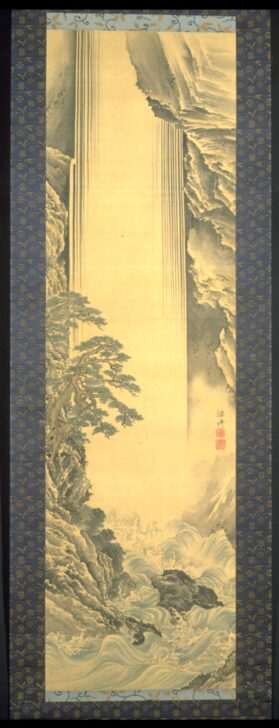Waterfall
Komai Genki

Description
Komai Genki 駒井源琦
Japan, 1747–1797
Waterfall
Edo period (1615–1868)
Second half of 18th century
Hanging scroll, ink and color on silk
Museum purchase made possible by the Margaret Watson Parker Art
Collection Fund, 1968/2.21
The monumental form of the waterfall depicted here is dramatically
reinforced by the vertical format of the hanging scroll. The artist
deftly employs multiple compositional devices—especially the use
of negative space—to convey a sense of the water’s rushing volume.
While the center of the composition is noticeably devoid of any detail
or texture, the edges and foreground can barely contain the brimming
force of the waterfall. For example, the gushing rapids at the bottom of
the painting, and the movement they convey, offer a vivid contrast to
the long vertical lines that suggest the tremendous force of the stream.
To the left and right of the waterfall, topographical features cut across
the water diagonally to suggest depth: the depiction of natural rock
formations at the top right, along with trees on the bottom left, creates
the illusion of receding planes projecting out into the viewer’s space.
So while the center of the composition is technically void of any color
or form, a middle ground emerges to contain the waterfall.
(Japanese Gallery Rotation, Summer 2025)
Subject Matter:
This painting shows a lot of different textures which range from the smooth waterfall to the rough waters below. The black pine tree to the left is a symbol of longevity and good fortune. This very natural scene incorporates the fluid force of water, the stable and solid stone, and the life of the black pine.
Physical Description:
This hanging scroll depicts what appears to be a large waterfall hidden by rock outcroppings. Towards the bottom left are pine trees growing on a rock. The water that the waterfall enters is rough and painted with a lot of movement. Just opposite of the pine tree is what appears to be the artist's signature written in black, quickly followed by an inscription in red. The scroll is framed by a blue and gold silk cloth with a floral inscription. There is a short stripe of a lighter blue-colored cloth with a different floral pattern on the top. The painting has splashes of color in the water, making it blue, and in the trees, making them green.
Usage Rights:
If you are interested in using an image for a publication, please visit https://umma.umich.edu/request-image/ for more information and to fill out the online Image Rights and Reproductions Request Form.